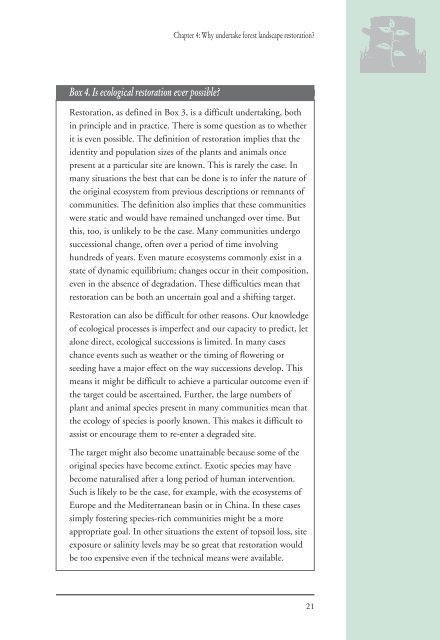Rehabilitation and Restoration Of Degraded Forests (PDF) - IUCN
Rehabilitation and Restoration Of Degraded Forests (PDF) - IUCN
Rehabilitation and Restoration Of Degraded Forests (PDF) - IUCN
You also want an ePaper? Increase the reach of your titles
YUMPU automatically turns print PDFs into web optimized ePapers that Google loves.
Box 4. Is ecological restoration ever possible?<br />
Chapter 4: Why undertake forest l<strong>and</strong>scape restoration?<br />
<strong>Restoration</strong>, as defined in Box 3, is a difficult undertaking, both<br />
in principle <strong>and</strong> in practice. There is some question as to whether<br />
it is even possible. The definition of restoration implies that the<br />
identity <strong>and</strong> population sizes of the plants <strong>and</strong> animals once<br />
present at a particular site are known. This is rarely the case. In<br />
many situations the best that can be done is to infer the nature of<br />
the original ecosystem from previous descriptions or remnants of<br />
communities. The definition also implies that these communities<br />
were static <strong>and</strong> would have remained unchanged over time. But<br />
this, too, is unlikely to be the case. Many communities undergo<br />
successional change, often over a period of time involving<br />
hundreds of years. Even mature ecosystems commonly exist in a<br />
state of dynamic equilibrium; changes occur in their composition,<br />
even in the absence of degradation. These difficulties mean that<br />
restoration can be both an uncertain goal <strong>and</strong> a shifting target.<br />
<strong>Restoration</strong> can also be difficult for other reasons. Our knowledge<br />
of ecological processes is imperfect <strong>and</strong> our capacity to predict, let<br />
alone direct, ecological successions is limited. In many cases<br />
chance events such as weather or the timing of flowering or<br />
seeding have a major effect on the way successions develop. This<br />
means it might be difficult to achieve a particular outcome even if<br />
the target could be ascertained. Further, the large numbers of<br />
plant <strong>and</strong> animal species present in many communities mean that<br />
the ecology of species is poorly known. This makes it difficult to<br />
assist or encourage them to re-enter a degraded site.<br />
The target might also become unattainable because some of the<br />
original species have become extinct. Exotic species may have<br />
become naturalised after a long period of human intervention.<br />
Such is likely to be the case, for example, with the ecosystems of<br />
Europe <strong>and</strong> the Mediterranean basin or in China. In these cases<br />
simply fostering species-rich communities might be a more<br />
appropriate goal. In other situations the extent of topsoil loss, site<br />
exposure or salinity levels may be so great that restoration would<br />
be too expensive even if the technical means were available.<br />
21

















